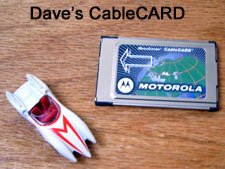Yesterday, we took a look back at 2006 and concluded high definition reaching a critical mass was the story of the year. For 2007, instead of forecasting the obvious (everyone gets HDTV – for less, digital media is everywhere) or making a bunch of wild predictions (Comcast buys TiVo), Dave and I wanted to focus on two notable dates.
Seven-Oh-Seven
 If you’re not in the business of broadband or consumer electronics, you’re probably not focused on the upcoming July 1st (7/07) CableCARD deadline. The CableCARD issue is sort of a subtopic in the larger story around the analog-to-digital TV transition. Nonetheless, the de-coupling of embedded security from set-top boxes has its own interesting history, and is worth a quick rundown:
If you’re not in the business of broadband or consumer electronics, you’re probably not focused on the upcoming July 1st (7/07) CableCARD deadline. The CableCARD issue is sort of a subtopic in the larger story around the analog-to-digital TV transition. Nonetheless, the de-coupling of embedded security from set-top boxes has its own interesting history, and is worth a quick rundown:
Cable Companies and CableCARD – Once Upon a Time
The difficult thing about making set-tops has traditionally been the embedded security features, called Conditional Access (CA). Two companies – Motorola and Scientific Atlanta – cornered the market on CA, and thus became the primary set-top manufacturers for cable operators large and small. The operators decided they wanted more vendor choices and so supported the idea of separating CA from set-top hardware. Separable security, i.e. the CableCARD was born.
CE Manufacturers and CableCARD
Consumer electronic companies want in on the cable broadband riches. If operators have to provide a CableCARD to enable security, then CE companies of all kinds (not just set-top manufacturers) can make products that plug in to the cable distribution network. The CE industry supports CableCARD.
The FCC and CableCARD
Competition = Good. The FCC supports CableCARD.
The CableCARD Fight Today
While cable companies like the idea of the CableCARD, they’ve discovered that it’s expensive to implement, and they’re the ones picking up the tab. To avoid the expense, operators have decided they’d like to skip right over CableCARD and go to a Downloadable Conditional Access System (DCAS). Many agree that DCAS would be wonderful and presumably cheaper, but, despite the fact that the technology has been demonstrated, it’s not yet ready for primetime. Cable operators have petitioned and won deadline extensions from the FCC, but now they’re running out of delay time. Unless a new ruling is passed down from the FCC, cable operators will have to stop shipping any set-tops that don’t support CableCARD by July 1st. The clock is ticking.
So what does all this mean? Without going into the technical limitations of CableCARD, it means cable companies are probably going to be spending more moola on new set-tops in the near-term. Expect to see some of these new set-tops at CES next week. And coming soon to a home near you.
I am a consumer with very little technical expertise regarding hdtv and cablecard, but I am puzzled about one thing, and maybe someone has an answer for the layperson like myself:
If cable companies are being required to support cablecard by July 1st 2007, why am I having so much darned trouble just finding any medium-sized hdtv’s with cable card slots? After searching and searching, I have noticed that most hdtv manufacturers came out with cablecard models in 2005, then stopped making these same models, and are only digital cable ready with the very large-sized hdtv’s. This is so ironic to me, as it is the medium and even smaller-sized tv’s that could use a cablecard slot. In my case, I want a tv to wall-hang in my eat-in kitchen,(26-32″), and I have no place to put a cable box, which is why I thought a cablecard ready tv would be the answer for me. I don’t want to wait for the 2nd generation cablecards. So, what is up with the tv manufacturers and what should someone like myself do, in the meantime? It is all so frustrating and no one seems to know the answers. Anyone out there…please comment your thoughts and ideas. Thanks!!
I feel for ya Linda C. I also agree with you. When will the people that make the decisions about what is available to consumers start listening to them? It’s a no-brainer that one of the best uses for cable card is in secondary viewing areas such as your eating area, bedrooms, offices, etc… If you boil off the fat, much of the blame for what’s wrong with TV program delivery these days rests squarely on the shoulders of the MPAA and the remainder has to do with cable company profits and manufacurer’s need for lower price points. You are being victimized by all three.
For you, since there isn’t a box-free option, you might contact an installation company in your area and have them install your cable box in a closet or the garage. They can arrange things so that your cable box remote control will still work while sitting in front of your TV. It shouldn’t be too expensive and it will work perfectly.
Or take the same closet and have your installation professionals set up a Windows Vista Media Center with dual cable cards. You can then extend your cable programming to as many as 5 TVs around the house using media extenders such as the xBox 360. (The kitchen’s extender would have to be in the closet of course.) In addition to digital TV throughout the house you would be able to record programs on the Vista hard drive, like a Tivo, and watch them from any TV. You would also be able to access your digital pictures in a slide show and play your MP3s, at any TV in the house.
Are there any 19-20′ cablecard-ready HDTVs, such as for the kitchen?